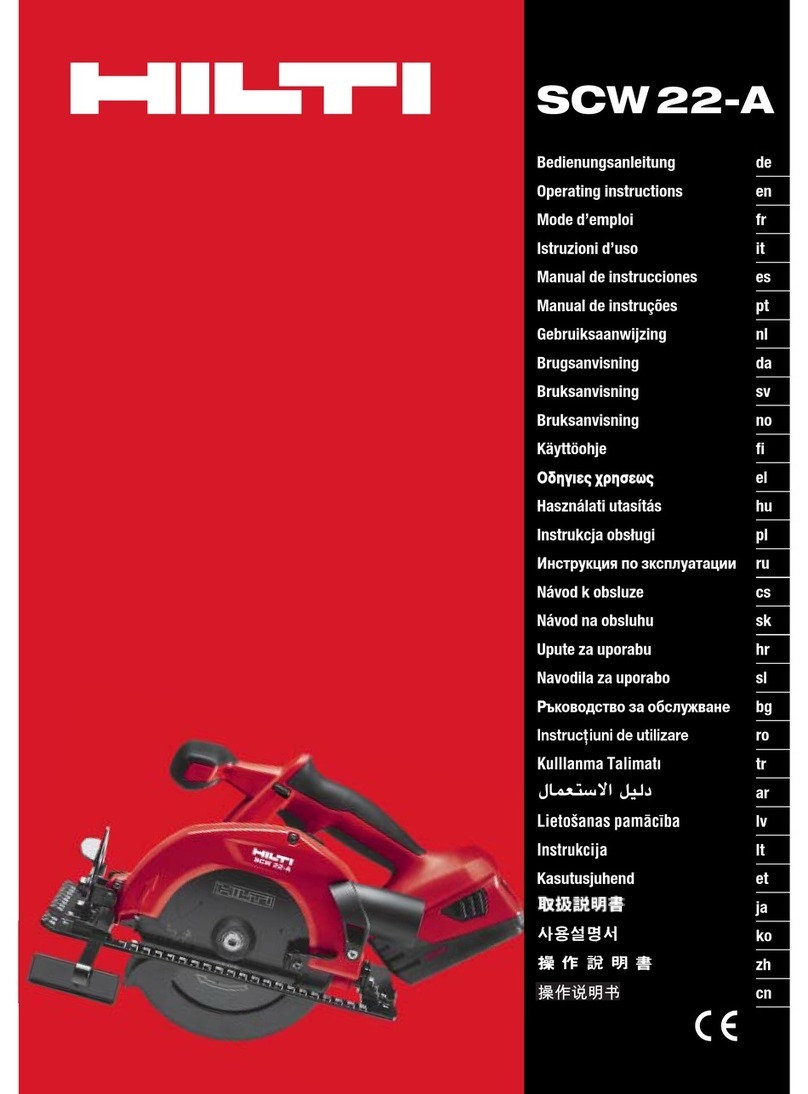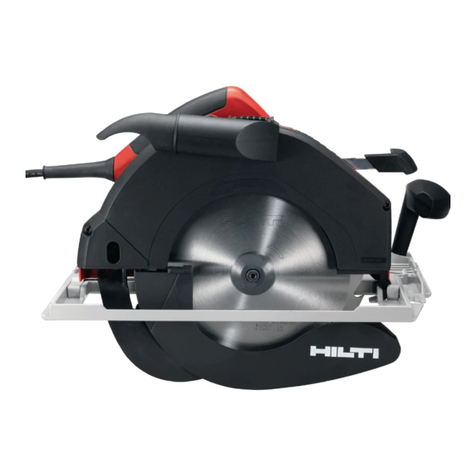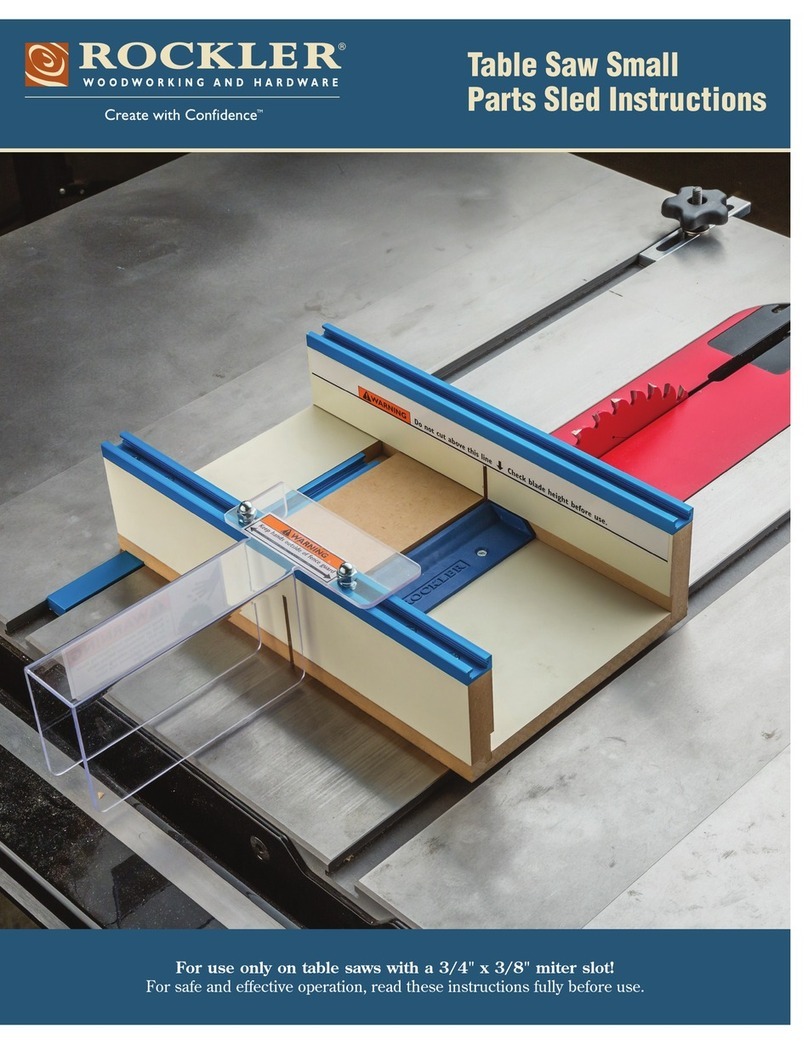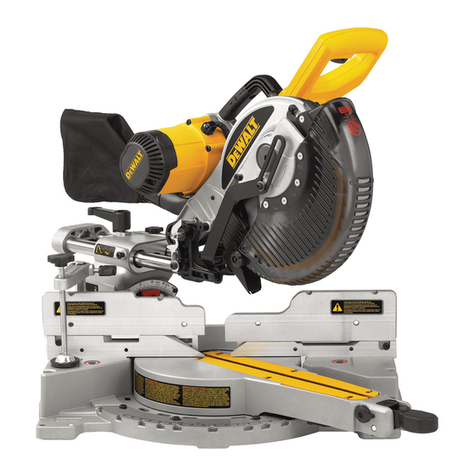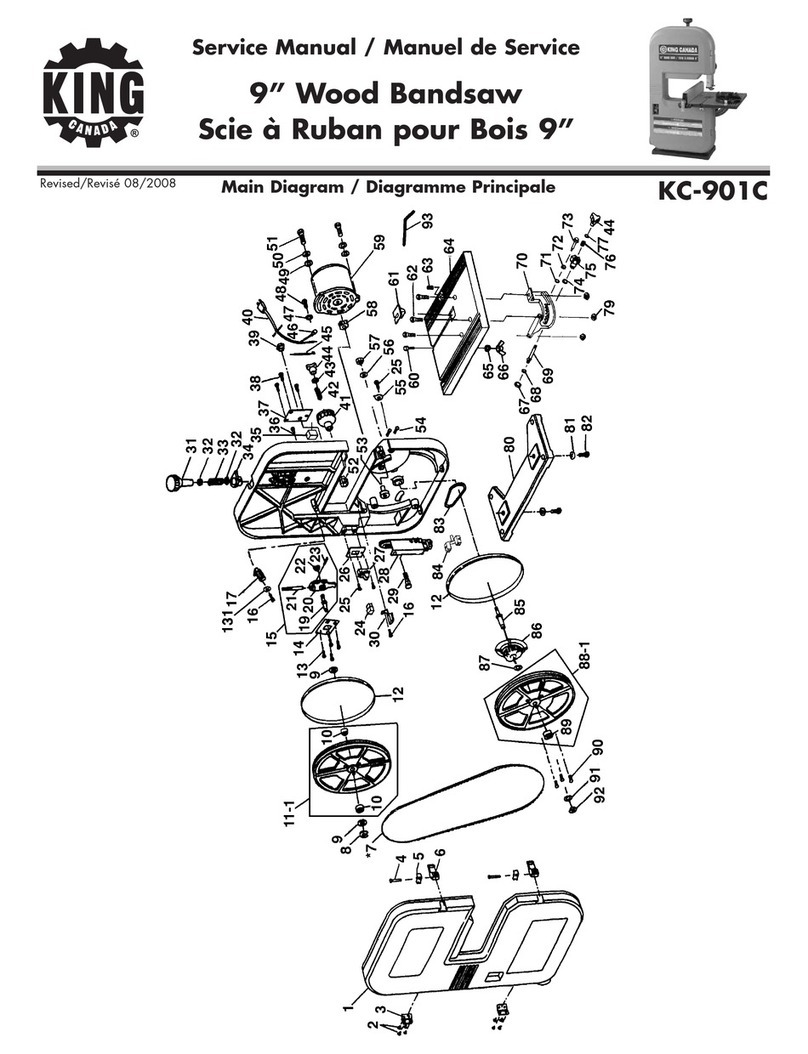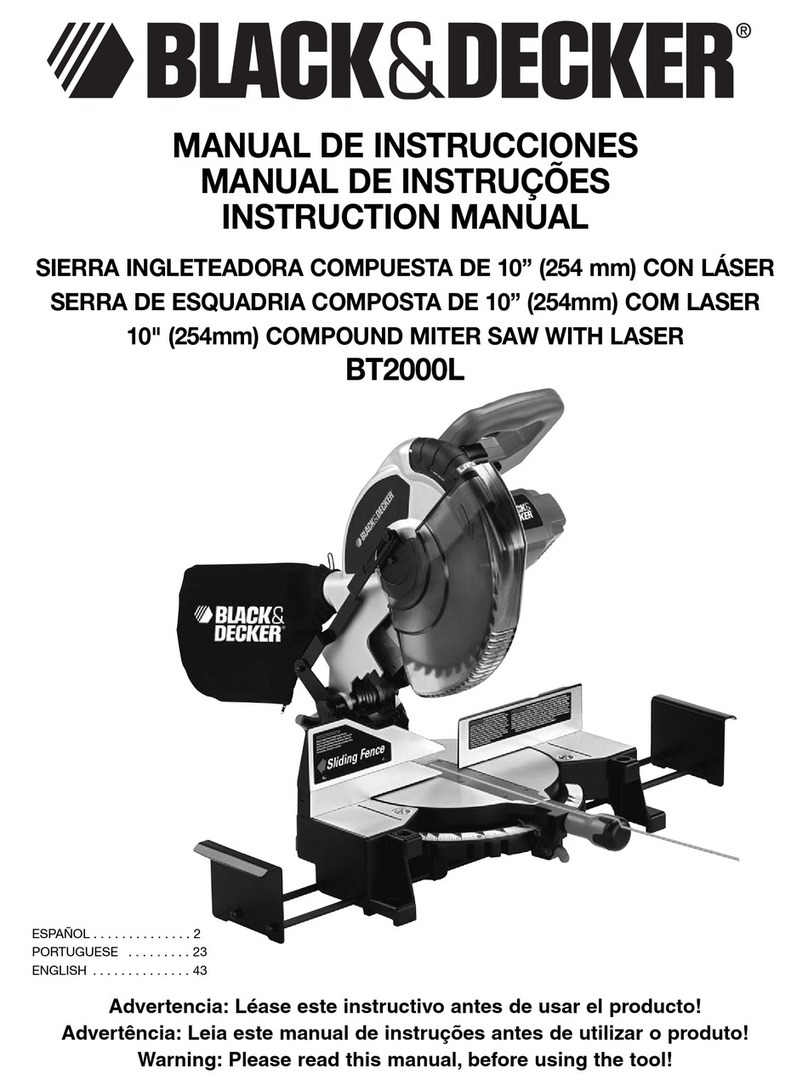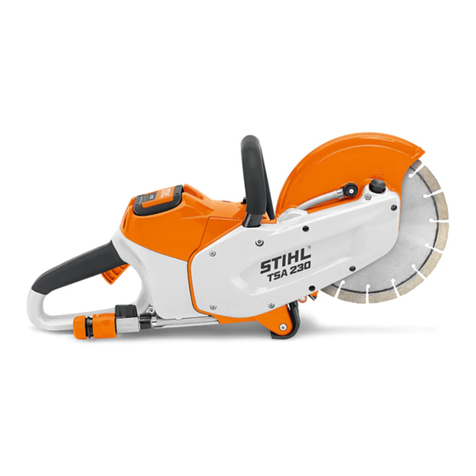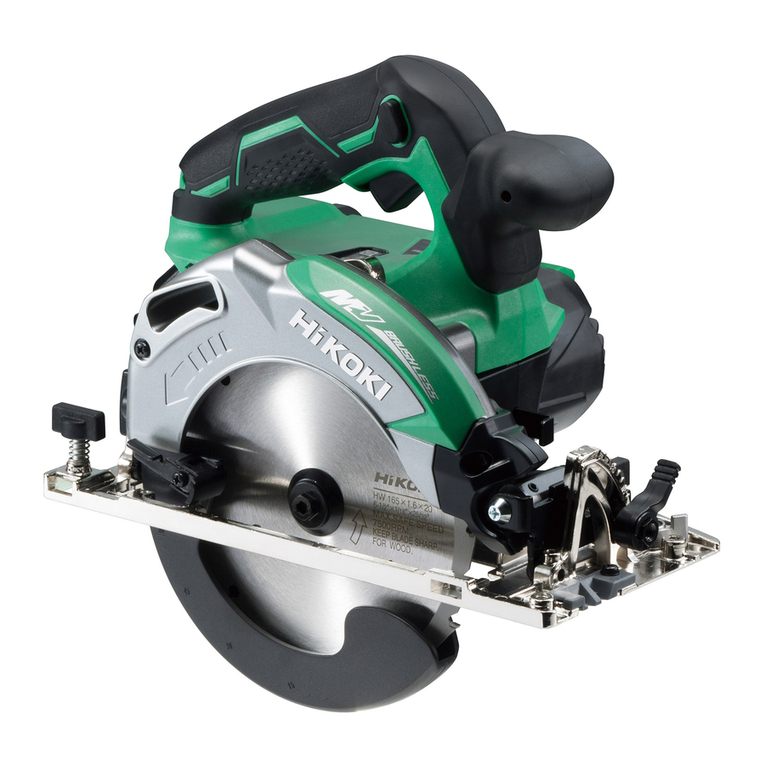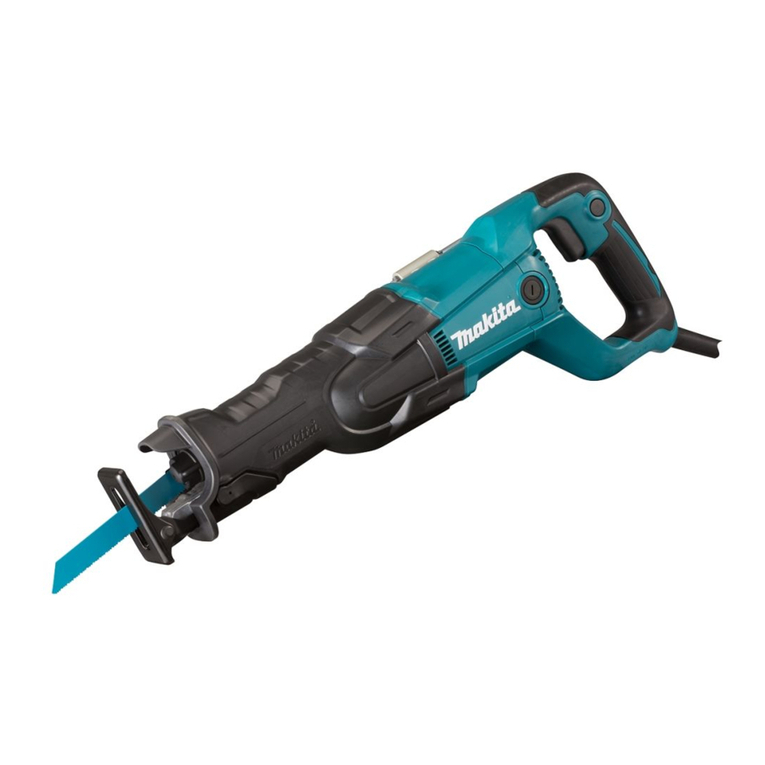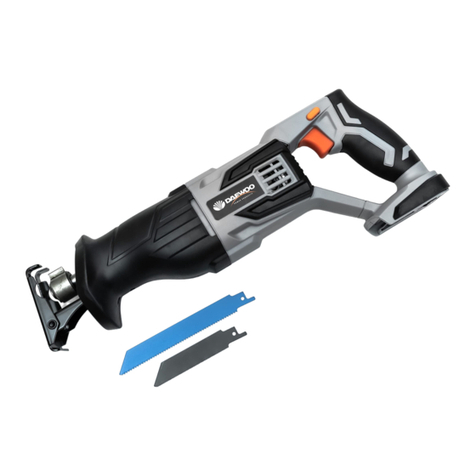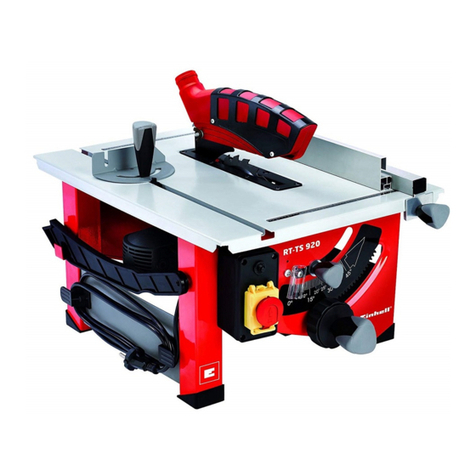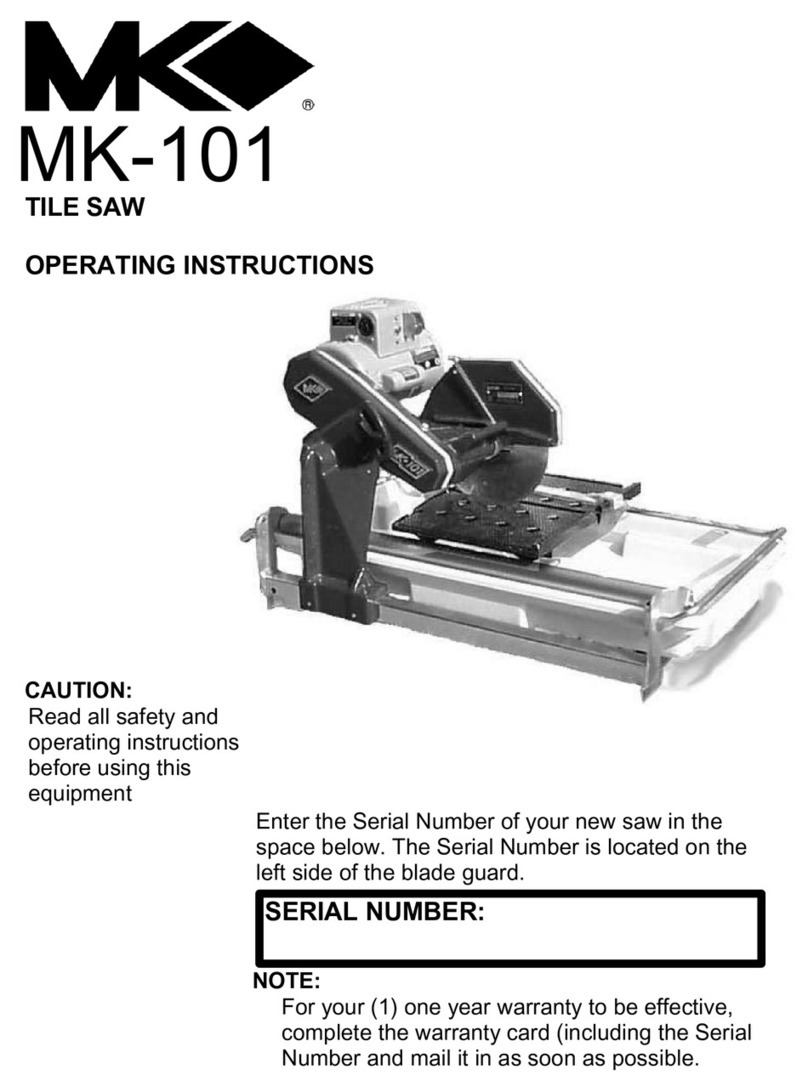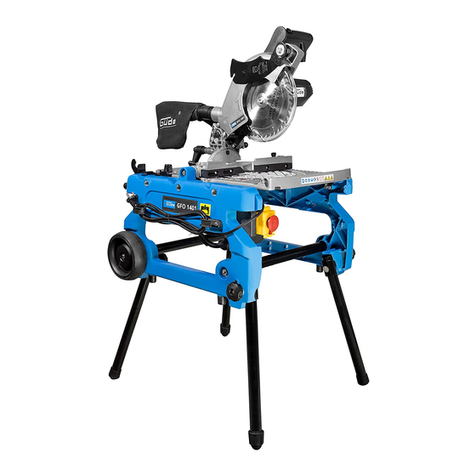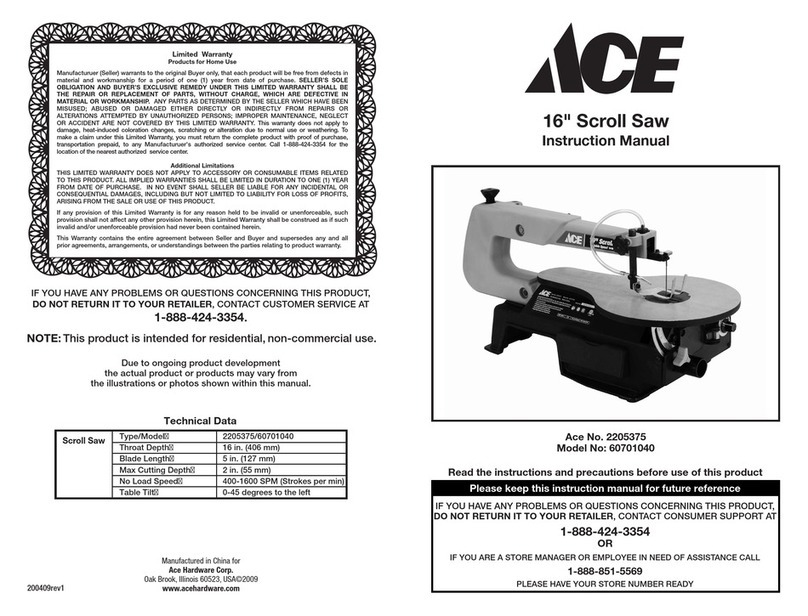Hilti WSC 85 User manual

WSC 85
English 1
Srpski 9
Printed: 18.09.2017 | Doc-Nr: PUB / 5374836 / 000 / 00

1
Printed: 18.09.2017 | Doc-Nr: PUB / 5374836 / 000 / 00

2
3
4
Printed: 18.09.2017 | Doc-Nr: PUB / 5374836 / 000 / 00

5
6
Printed: 18.09.2017 | Doc-Nr: PUB / 5374836 / 000 / 00

English 1
1 Information about the documentation
1.1 About this documentation
• Read this documentation before initial operation or use. This is a prerequisite for safe, trouble-free
handling and use of the product.
• Observe the safety instructions and warnings in this documentation and on the product.
• Always keep the operating instructions with the product and make sure that the operating instructions
are with the product when it is given to other persons.
1.2 Explanation of signs used
1.2.1 Warnings
Warnings alert persons to hazards that occur when handling or using the product. The following signal words
are used in combination with a symbol:
DANGER! Draws attention to imminent danger that will lead to serious personal injury or fatality.
WARNING! Draws attention to a potential hazard that could lead to serious personal injury or
fatality.
CAUTION! Draws attention to a potentially dangerous situation that could lead to minor personal
injury or damage to the equipment or other property.
1.2.2 Symbols in the documentation
The following symbols are used in this document:
Read the operating instructions before use
Instructions for use and other useful information
1.2.3 Symbols in the illustrations
The following symbols are used in illustrations:
These numbers refer to the corresponding illustrations found at the beginning of these operating
instructions.
The numbering reflects the sequence of operations shown in the illustrations and may deviate
from the steps described in the text.
Item reference numbers are used in the overview illustrations and refer to the numbers used in
the product overview section.
These characters are intended to specifically draw your attention to certain points when handling
the product.
1.3 Product information
Hilti products are designed for professional use and may be operated, serviced and maintained only by
trained, authorized personnel. This personnel must be informed of any particular hazards that may be
encountered. The product and its ancillary equipment can present hazards if used incorrectly by untrained
personnel or if used not in accordance with the intended use.
The type designation and serial number are stated on the rating plate.
▶Write down the serial number in the table below. You will be required to state the product details when
contacting Hilti Service or your local Hilti organization to inquire about the product.
Product information
Type: WSC 85
Generation: 01
Serial no.:
Printed: 18.09.2017 | Doc-Nr: PUB / 5374836 / 000 / 00

2 English
1.4 Declaration of conformity
We declare, on our sole responsibility, that the product described here complies with the applicable directives
and standards. A copy of the declaration of conformity can be found at the end of this documentation.
The technical documentation is filed and stored here:
Hilti Entwicklungsgesellschaft mbH | Tool Certification | Hiltistrasse 6 | 86916 Kaufering, Germany
2 Safety
2.1 General power tool safety warnings
WARNING Read all safety warnings, instructions, illustrations and specifications provided with this
power tool. Failure to follow the instructions below may result in electric shock, fire and/or serious injury.
Save all warnings and instructions for future reference.
The term "power tool" in the warnings refers to your mains-operated (corded) power tool or battery-operated
(cordless) power tool.
Work area safety
▶Keep your work area clean and well lit. Cluttered or dark work areas invite accidents.
▶Do not operate the power tool in explosive atmospheres, such as in the presence of flammable
liquids, gases or dust. Power tools create sparks which may ignite the dust or fumes.
▶Keep children and bystanders away while operating a power tool. Distractions can cause you to lose
control.
Electrical safety
▶Power tool plugs must match the outlet. Never modify the plug in any way. Do not use any adapter
plugs with earthed (grounded) power tools. Unmodified plugs and matching power outlets reduce the
risk of electric shock.
▶Avoid body contact with earthed or grounded surfaces, such as pipes, radiators, ranges and
refrigerators. There is an increased risk of electric shock if your body is earthed or grounded.
▶Do not expose power tools to rain or wet conditions. Water entering a power tool will increase the
risk of electric shock.
▶Do not abuse the cord. Never use the cord for carrying, pulling or unplugging the power tool. Keep
cord away from heat, oil, sharp edges or moving parts. Damaged or entangled cords increase the
risk of electric shock.
▶When operating a power tool outdoors, use an extension cord suitable for outdoor use. Use of a
cord suitable for outdoor use reduces the risk of electric shock.
▶If operating a power tool in a damp location is unavoidable, use a residual current device (RCD)
protected supply. Use of an RCD reduces the risk of electric shock.
Personal safety
▶Stay alert, watch what you are doing and use common sense when operating a power tool. Do
not use a power tool while you are tired or under the influence of drugs, alcohol or medication. A
moment of inattention while operating the power tool may result in serious personal injury.
▶Use personal protective equipment. Always wear eye protection. Protective equipment such as a
dust mask, non-skid safety shoes, hard hat or hearing protection used for appropriate conditions will
reduce personal injuries.
▶Prevent unintentional starting. Ensure the switch is in the off-position before connecting to power
source and/or battery pack, picking up or carrying the tool. Carrying power tools with your finger on
the switch or energising power tools that have the switch on invites accidents.
▶Remove any adjusting key or wrench before turning the power tool on. A wrench or a key left
attached to a rotating part of the power tool may result in personal injury.
▶Do not overreach. Keep proper footing and balance at all times. This enables better control of the
power tool in unexpected situations.
▶Dress properly. Do not wear loose clothing or jewellery. Keep your hair and clothing away from
moving parts. Loose clothes, jewellery or long hair can be caught in moving parts.
▶If devices are provided for the connection of dust extraction and collection facilities, ensure these
are connected and properly used. Use of dust collection can reduce dust-related hazards.
▶Do not let familiarity gained from frequent use of tools allow you to become complacent and ignore
tool safety principles. A careless action can cause severe injury within a fraction of a second.
Printed: 18.09.2017 | Doc-Nr: PUB / 5374836 / 000 / 00

English 3
Power tool use and care
▶Do not force the power tool. Use the correct power tool for your application. The correct power tool
will do the job better and safer at the rate for which it was designed.
▶Do not use the power tool if the switch does not turn it on and off. Any power tool that cannot be
controlled with the switch is dangerous and must be repaired.
▶Disconnect the plug from the power source and/or remove the battery pack, if detachable, from
the power tool before making any adjustments, changing accessories, or storing power tools.
Such preventive safety measures reduce the risk of starting the power tool accidentally.
▶Store idle power tools out of the reach of children and do not allow persons unfamiliar with the
power tool or these instructions to operate the power tool. Power tools are dangerous in the hands
of untrained users.
▶Maintain power tools and accessories. Check for misalignment or binding of moving parts,
breakage of parts and any other condition that may affect the power tool’s operation. If damaged,
have the power tool repaired before use. Many accidents are caused by poorly maintained power
tools.
▶Keep cutting tools sharp and clean. Properly maintained cutting tools with sharp cutting edges are
less likely to bind and are easier to control.
▶Use the power tool, accessories and tool bits etc. in accordance with these instructions, taking
into account the working conditions and the work to be performed. Use of the power tool for
operations different from those intended could result in a hazardous situation.
▶Keep handles and grasping surfaces dry, clean and free from oil and grease. Slippery handles and
grasping surfaces do not allow for safe handling and control of the tool in unexpected situations.
Service
▶Have your power tool serviced by a qualified repair person using only identical replacement parts.
This will ensure that the safety of the power tool is maintained.
2.2 Safety instructions for all saws
Cutting procedures
▶DANGER: Keep hands away from cutting area and the blade. Keep your second hand on
auxiliary handle or motor housing. If both hands are holding the saw, they cannot be cut by the blade.
▶Do not reach underneath the workpiece. The guard cannot protect you from the blade below the
workpiece.
▶Adjust the cutting depth to the thickness of the workpiece. Less than a full tooth of the blade teeth
should be visible below the workpiece.
▶Never hold the workpiece in your hands or across your leg while cutting. Secure the workpiece
to a stable platform. It is important to support the work properly to minimise body exposure, blade
binding, or loss of control.
▶Hold the power tool by insulated gripping surfaces, when performing an operation where the
cutting tool may contact hidden wiring or its own cord. Contact with a "live" wire will also make
exposed metal parts of the power tool "live" and could give the operator an electric shock.
▶When ripping, always use a rip fence or straight edge guide. This improves the accuracy of cut and
reduces the chance of blade binding.
▶Always use blades with correct size and shape (diamond versus round) of arbour holes. Blades
that do not match the mounting hardware of the saw will run off-centre, causing loss of control.
▶Never use damaged or incorrect blade washers or bolt. The blade washers and bolt were specially
designed for your saw, for optimum performance and safety of operation.
Kickback causes and related warnings
• kickback is a sudden reaction to a pinched, jammed or misaligned saw blade, causing an uncontrolled
saw to lift up and out of the workpiece toward the operator;
• when the blade is pinched or jammed tightly by the kerf closing down, the blade stalls and the motor
reaction drives the unit rapidly back toward the operator;
• if the blade becomes twisted or misaligned in the cut, the teeth at the back edge of the blade can dig
into the top surface of the wood causing the blade to climb out of the kerf and jump back toward the
operator.
Kickback is the result of saw misuse and/or incorrect operating procedures or conditions and can be avoided
by taking proper precautions as given below.
▶Maintain a firm grip with both hands on the saw and position your arms to resist kickback forces.
Position your body to either side of the blade, but not in line with the blade. Kickback could cause
Printed: 18.09.2017 | Doc-Nr: PUB / 5374836 / 000 / 00

4 English
the saw to jump backwards, but kickback forces can be controlled by the operator, if proper precautions
are taken.
▶When blade is binding, or when interrupting a cut for any reason, release the trigger and hold the
saw motionless in the material until the blade comes to a complete stop. Never attempt to remove
the saw from the work or pull the saw backward while the blade is in motion or kickback may
occur. Investigate and take corrective actions to eliminate the cause of blade binding.
▶When restarting a saw in the workpiece, centre the saw blade in the kerf so that the saw teeth are
not engaged into the material. If a saw blade binds, it may walk up or kickback from the workpiece as
the saw is restarted.
▶Support large panels to minimise the risk of blade pinching and kickback. Large panels tend to sag
under their own weight. Supports must be placed under the panel on both sides, near the line of cut and
near the edge of the panel.
▶Do not use dull or damaged blades. Unsharpened or improperly set blades produce narrow kerf
causing excessive friction, blade binding and kickback.
▶Blade depth and bevel adjusting locking levers must be tight and secure before making the cut. If
blade adjustment shifts while cutting, it may cause binding and kickback.
▶Use extra caution when sawing into existing walls or other blind areas. The protruding blade may
cut objects that can cause kickback.
Lower guard function
▶Check the lower guard for proper closing before each use. Do not operate the saw if the lower
guard does not move freely and close instantly. Never clamp or tie the lower guard into the open
position. If the saw is accidentally dropped, the lower guard may be bent. Raise the lower guard with
the retracting handle and make sure it moves freely and does not touch the blade or any other part, in all
angles and depths of cut.
▶Check the operation of the guard return spring. If the guard and the spring are not operating
properly, they must be serviced before use. Lower guard may operate sluggishly due to damaged
parts, gummy deposits, or a build-up of debris.
▶The lower guard may be retracted manually only for special cuts such as "plunge cuts" and
"compound cuts". Raise the lower guard by the retracting handle and as soon as the blade enters
the material, the lower guard must be released. For all other sawing, the lower guard should operate
automatically.
▶Always observe that the lower guard is covering the blade before placing the saw down on bench
or floor. An unprotected, coasting blade will cause the saw to walk backwards, cutting whatever is in its
path. Be aware of the time it takes for the blade to stop after switch is released.
Guard function
▶Check the guard for proper closing before each use. Do not operate the saw if the guard does
not move freely and enclose the blade instantly. Never clamp or tie the guard so that the blade is
exposed. If the saw is accidentally dropped, the guard may be bent. Check to make sure that the guard
moves freely and does not touch the blade or any other part, in all angles and depths of cut.
▶Check the operation and condition of the guard return spring. If the guard and the spring are
not operating properly, they must be serviced before use. The guard may operate sluggishly due to
damaged parts, gummy deposits, or a build-up of debris.
▶Assure that the base plate of the saw will not shift while performing a “plunge cut”. Blade shifting
sideways will cause binding and likely kick back.
▶Always observe that the guard is covering the blade before placing the saw down on bench or
floor. An unprotected, coasting blade will cause the saw to walk backwards, cutting whatever is in its
path. Be aware of the time it takes for the blade to stop after the switch is released.
Riving knife function
▶Use the appropriate saw blade for the riving knife. For the riving knife to function, the body of the
blade must be thinner than the riving knife and the cutting width of the blade must be wider than the
thickness of the riving knife.
▶Adjust the riving knife as described in this instruction manual. Incorrect spacing, positioning and
alignment can make the riving knife ineffective in preventing kickback.
▶Always use the riving knife except when plunge cutting. The riving knife must be replaced after
plunge cutting. The riving knife causes interference during plunge cutting and can create kickback.
▶For the riving knife to work, it must be engaged in the workpiece. The riving knife is ineffective in
preventing kickback during short cuts.
▶Do not operate the saw if the riving knife is bent. Even a light interference can slow the closing rate of
a guard.
Printed: 18.09.2017 | Doc-Nr: PUB / 5374836 / 000 / 00

English 5
3 Description
3.1 Overview of the product 1
@Sawdust ejection
;On/off switch
=Cutting angle scale
%Clamping screw for blade angle adjustment
&Clamping screw for rip fence
(Cutting line indicator
)Cutting depth scale
+Pivoting guard
§Rip fence (parallel guide)
/Riving knife
:Securing screws for riving knife
∙Switch-on interlock release button
$Suction adapter
£Clamping screw for rip fence
|Lock for cutting depth
¡Base plate
QDrive spindle lock button
WAir vents
EHexagon socket wrench
RAuxiliary grip
TAdjusting lever for cutting depth
3.2 Intended use
The product described is a circular saw. It is designed for cutting wood or wood-like materials, plastics,
gypsum plasterboard, gypsum fiberboard and composite materials, up to a cutting depth of 85 mm (3.35 in).
The circular saw is equipped with a removable connector for an optional vacuum cleaner / dust removal
hose. This connector is designed to fit standard suction hoses. In order to connect the vacuum cleaner hose
to the saw, use of a suitable adapter may be necessary.
3.2.1 Possible misuse
The use of saw blades that do not comply with the specifications given in the technical data or the use of
cutting and grinding discs or blades made from high-alloy steel (HSS steel) is not permissible. Sawing metals
is not permissible.
3.3 Items supplied
Circular saw, operating instructions.
Note
To help ensure safe and reliable operation, use only genuine Hilti spare parts and consumables. Spare
parts, consumables and accessories approved by Hilti for use with the product can be found at your
local Hilti Center or online at: www.hilti.group
4 Technical data
4.1 Technical data
Note
For details of the rated voltage, frequency, current and input power, refer to the country-specific type
identification plate.
If the device is powered by a generator or transformer, the generator or transformer’s power output must be
at least twice the rated input power shown on the rating plate of the device. The operating voltage of the
transformer or generator must always be within +5 % and -15 % of the rated voltage of the device.
WSC 85
Power output 1,260 W
No-load speed 4,500 /min
Speed under load 3,100 /min
Cutting speed under no load 54 m/s
Cutting speed under load 37.3 m/s
Cutting depth at 0 ° 0 mm …85 mm
Cutting depth at 45 ° 0 mm …60 mm
Printed: 18.09.2017 | Doc-Nr: PUB / 5374836 / 000 / 00

6 English
WSC 85
Cutting depth at 60° 0 mm …43 mm
Saw blade diameter 207 mm …230 mm
Saw blade arbor size 30 mm
Riving knife thickness (standard) 2 mm
Weight in accordance with EPTA procedure 01 7.8 kg
Protection class II
4.2 Noise information and vibration values in accordance with EN 62841
The sound pressure and vibration values given in these instructions were measured in accordance with a
standardized test and can be used to compare one power tool with another. They can also be used for a
preliminary assessment of exposure.
The data given represent the main applications of the power tool. However, if the power tool is used for
different applications, with different accessory tools, or is poorly maintained, the data can vary. This can
significantly increase exposure over the total working period.
An accurate estimation of exposure should also take into account the times when the tool is switched off, or
when it is running but not actually being used for a job. This can significantly reduce exposure over the total
working period.
Identify additional safety measures to protect the operator from the effects of noise and/or vibration, for
example: maintaining the power tool and accessory tools, keeping the hands warm, organization of work
patterns.
Noise information
WSC 85
Typical A-weighted sound power level 111 dB(A)
Typical A-weighted emission sound pressure level 100 dB(A)
Uncertainty 3 dB(A)
Vibration information
WSC 85
Triaxial vibration value when cutting wood (ah)≈ 2.5 m/s²
Uncertainty (K) 1.5 m/s²
5 Operation
5.1 Removing the saw blade 2
WARNING
Risk of burning injury. A hot accessory tool, clamping flange or clamping screw and the sharp edges
of the saw blade present hazards.
▶Wear protective gloves when changing saw blades.
1. Rest the power tool on the ribbing.
2. Lock the spindle by holding the drive-spindle lock button down with one hand.
3. Use an Allen key to slacken the flange screw underneath the motor cover.
4. Use the adjusting lever to set the cutting depth to 0.
5. Use the Allen key to turn the screw counter-clockwise to remove.
6. Remove the clamping flange.
7. Open the pivoting guard.
8. Hold the pivoting guard so that it does not move.
9. Remove the saw blade.
Printed: 18.09.2017 | Doc-Nr: PUB / 5374836 / 000 / 00

English 7
5.2 Fitting the saw blade 3
CAUTION
Risk of damage Unsuitable or incorrectly fitted saw blades may damage the saw.
▶Only use blades which are suitable for this saw. Observe the direction-of-rotation arrow on the
saw blade.
1. Rest the power tool on the ribs provided.
2. Lock the arbor by holding the arbor lockbutton down with one hand.
3. Fit the clamping flange to the arbor.
4. Securely tighten the screw.
5. Make sure that the clamping flange is seated correctly.
Note
The riving knife thickness must be less than the kerf width of the saw blade and at least equal to
the saw blade disc thickness.
Gap A must be less than 5 mm (0.2 in).
5.3 Adjusting the cutting depth 4
1. Release the lock.
2. Set the cutting depth with the lever for the cutting depth.
◁The cutting depth is shown on the cutting depth scale.
Note
For a clean-edged cut, set cutting depth to the thickness of the material plus 2 mm.
3. Secure the lock.
5.4 Plunge function 4
Note
You can use the plunge function with the saw blade set to any cutting angle.
1. Set the cutting depth. → page 7
◁Set the cutting depth to 0.
2. Position the saw on the workpiece.
◁Bring the rear mark on the base plate into alignment with the cutting line.
Note
To reduce the risk of kickback, secure a stop piece to the workpiece directly behind the base plate.
3. Release the cutting depth locking mechanism.
4. Press the saw against the workpiece and against the stop.
5. Switch the power tool on. → page 8
6. Set the cutting depth. → page 7
7. Make the cut.
8. Switch the power tool off. → page 8
9. Wait until the saw blade has stopped rotating.
10. Lift the saw clear.
5.5 Setting the cutting angle 5
1. Remove sawdust from the base plate.
2. Slacken the clamping screw.
3. Pivot the base plate to the desired cutting angle.
◁The cutting angle is shown on the cutting angle scale.
4. Tighten the clamping screw.
Printed: 18.09.2017 | Doc-Nr: PUB / 5374836 / 000 / 00

8 English
5.6 Fitting / adjusting the rip fence (parallel guide) 6
1. To adjust the cutting width, slacken the clamping screws.
2. Push the parallel guide into the base plate as far as desired.
3. Tighten the clamping screws.
5.7 Switching the power tool on
1. Press the safety lock.
2. Press the on/off switch.
5.8 Sawing along a line
Note
Secure the workpiece to prevent movement.
Position the workpiece so that the saw blade is free to rotate beneath it.
Check to ensure that the on/off switch on the product is in the “off” position.
Position the forward section of the saw’s base plate on the workpiece but do not bring the blade into
contact with the workpiece.
1. Bring the front edge of the base plate into contact with the workpiece.
2. Switch the power tool on. → page 8
3. Guide the product along the cutting line on the workpiece at a suitable speed.
5.9 Switching the power tool off
▶Release the on/off switch.
6 Care and maintenance
6.1 Checks after cleaning and maintenance
Note
After cleaning or maintenance, check that all safety devices are fitted and that they function faultlessly.
▶To check the pivoting guard, open the guard fully by moving the guard operating lever.
◁The pivoting guard must close quickly and completely when the guard operating lever is released.
6.2 Cleaning the guard
1. Remove the saw blade. → page 6
2. Clean the parts of the guard carefully with a dry brush.
3. Use a suitable tool to remove deposits or cuttings from the inside surfaces of the parts of the guard.
4. Fit the saw blade. → page 7
7 Disposal
Most of the materials from which Hilti tools and appliances are manufactured can be recycled. The
materials must be correctly separated before they can be recycled. In many countries, your old tools,
machines or appliances can be returned to Hilti for recycling. Ask Hilti Service or your Hilti representative
for further information.
▶Disposal of electric tools or appliances together with household waste is not permissible.
8 Manufacturer’s warranty
▶Please contact your local Hilti representative if you have questions about the warranty conditions.
Printed: 18.09.2017 | Doc-Nr: PUB / 5374836 / 000 / 00

Srpski 9
1 Podaci o dokumentaciji
1.1 O ovoj dokumentaciji
• Pročitajte ovu dokumentaciju pre početka rada. To predstavlja preduslov za bezbedan rad i nesmetano
rukovanje.
• Obratite pažnju na bezbednosne i upozoravajuće napomene koje se nalaze u ovoj dokumentaciji i na
proizvodu.
• Uputstvo za rukovanje uvek čuvajte na proizvodu i samo ga sa ovim uputstvom prosleđujte dalje drugim
osobama.
1.2 Legenda
1.2.1 Upozoravajuće napomene
Upozoravajuće napomene upozoravaju na opasnosti pri rukovanju proizvodom. Koriste se sledeće signalne
reči u kombinaciji sa simbolom:
OPASNOST! Znači neposrednu opasnu situaciju, koja može prouzrokovati telesne povrede ili
smrt.
UPOZORENJE! Ova reč skreće pažnju na moguću opasnost koja može prouzrokovati tešku
telesnu povredu ili smrt.
OPREZ! Za moguću opasnu situaciju koja može da dovede do lakših telesnih povreda ili do
materijalne štete
1.2.2 Simboli u dokumentaciji
Sledeći simboli se koriste u ovoj dokumentаciji:
Pre upotrebe pročitajte uputstvo za upotrebu
Napomene o primeni i druge korisne informacije
1.2.3 Simboli na slikama
Sledeći simboli se koriste na slikama:
Ovi brojevi se odnose na odgovarajuću sliku sa početka ovog uputstva
Numerisanje reflektuje redosled radnih koraka na slici i može da odstupa od radnih koraka u
tekstu
Pozicioni brojevi se koriste na slici Pregled i odnose se na brojeve legende u poglavlju Pregled
proizvoda.
Ovaj znak bi trebalo da vas podstakne na poseban oprez prilikom rada sa proizvodom.
1.3 Informacije o proizvodu
Hilti proizvodi su namenjeni za profesionalnog korisnika, a njima sme da rukuje, da ih održava ili popravlja
samo ovlašćeno i obučeno osoblje. To osoblje mora biti posebno upoznato sa mogućim opasnostima.
Proizvod i njegova pomoćna sredstva mogu da budu opasni ako ih neobučena lica nestručno tretiraju ili ako
se ne koriste namenski.
Oznaka tipa i serijski broj su navedeni na tipskoj pločici.
▶Prenesite serijski broj u sledeću tabelu. Podaci o proizvodu će vam biti potrebni kada budete kontaktirali
naše predstavništvo ili servis.
Podaci o proizvodu
Tip: WSC 85
Generacija: 01
Serijski br.:
Printed: 18.09.2017 | Doc-Nr: PUB / 5374836 / 000 / 00

10 Srpski
1.4 Izjava o usklađenosti
Pod vlastitom odgovornošću izjavljujemo da je ovde opisani proizvod u skladu sa važećim smernicama i
normama. Primerak izjave o usklađenosti nalazi se na kraju ove dokumentacije.
Tehnička dokumentacija se čuva ovde:
Hilti Entwicklungsgesellschaft mbH | Zulassung Geräte | Hiltistraße 6 | 86916 Kaufering, DE
2 Sigurnost
2.1 Opšte sigurnosne napomene za električne alate
UPOZORENJE Pročitajte pažljivo sigurnosne napomene, uputstva, pregledajte slike i pročitajte
tehničke podatke, koje idu uz ovaj električni alat. Greške kod pridržavanja sledećih sigurnosnih napomena
i uputstava mogu dovesti do električnog udara, požara i/ili teških povreda.
Molimo sačuvajte sve sigurnosne napomene i uputstva za ubuduće.
Pojam "električni alat" korišćen u sigurnosnim napomenama odnosi se na električne alate sa napajanjem iz
električne mreže (sa mrežnim kablom) i na električne alate sa pogonom na akumulatore (bez mrežnog kabla).
Sigurnost na radnom mestu
▶Područje rada održavajte čistim i osvetljenim. Nered i neosvetljeno radno područje mogu dovesti do
nezgoda.
▶Sa električnim alatom ne radite u okolini ugroženoj eksplozijom, u kojoj se nalaze zapaljive
tečnosti, gasovi ili prašine. Električni alati proizvode iskre koje mogu zapaliti prašinu ili isparenja.
▶Decu i ostale osobe tokom korišćenja električnog alata udaljite iz područja rada. Ako biste skrenuli
pažnju sa posla mogli biste izgubiti kontrolu nad alatom.
Električna sigurnost
▶Priključni utikač električnog alata treba da odgovara utičnici. Na utikaču se ni u kom slučaju ne
smeju izvoditi izmene. Ne koristite adapterske utikače zajedno sa zaštitno uzemljenim električnim
alatima. Nepromenjeni utikači i odgovarajuće utičnice smanjuju opasnost od električnog udara.
▶Izbegavajte dodir tela sa uzemljenim površinama kao što su cevi, radijatori, šporeti i frižideri.
Postoji povećana opasnost od električnog udara ako je vaše telo uzemljeno.
▶Električni alat držite dalje od kiše ili vlage. Prodiranje vode u električni alat povećava opasnost od
električnog udara.
▶Kabl ne upotrebljavajte za nošenje ili vešanje električnog alata odnosno za izvlačenje utikača iz
utičnice. Kabl držite dalje od izvora toplote, ulja, oštrih ivica ili pokretnih delova. Oštećeni ili
zapleteni kablovi povećavaju opasnost od električnog udara.
▶Ako sa električnim alatom radite na otvorenom prostoru, upotrebljavajte samo produžne kablove
odobrene za upotrebu na otvorenom prostoru. Primena produžnog kabla prikladnog za upotrebu na
otvorenom prostoru smanjuje opasnost od električnog udara.
▶Ako ne možete izbeći rad električnog alata u vlažnom okruženju, koristite zaštitnu strujnu sklopku.
Upotreba zaštitne strujne sklopke smanjuje opasnost od električnog udara.
Sigurnost ljudi
▶Budite oprezni, pazite šta činite i kod rada sa električnim alatom postupajte razumno. Nemojte
koristiti električni alat, ako ste umorni ili ste pod uticajem droga, alkohola ili lekova. Momenat
nepažnje prilikom upotrebe električnog alata može da dovede do ozbiljnih povreda.
▶Nosite sredstva lične zaštite i uvek zaštitne naočare. Nošenje sredstava lične zaštite, kao što su
zaštitna maska, sigurnosne cipele koje ne klize, zaštitna kaciga ili štitnik za sluh, u zavisnosti od vrste i
primene električnog alata, smanjuje opasnost od nezgoda.
▶Izbegavajte nehotično stavljanje u pogon. Uverite se, da je električni alat isključen, pre nego što
priključite snabdevanje naponom i/ili akumulator, ili ga primite ili nosite. Ako kod nošenja električnog
alata prst držite na prekidaču ili ako je alat uključen i priključen na električnu mrežu, to može dovesti do
nezgoda.
▶Pre nego što uključite električni alat, uklonite alate za podešavanje ili vijčane ključeve. Alat ili ključ
koji se nalazi u rotirajućem delu alata može dovesti do nezgoda.
▶Izbegavajte nenormalan položaj tela. Zauzmite siguran i stabilan položaj tela i u svakom trenutku
održavajte ravnotežu. Na taj način električni alat možete bolje kontrolisati u neočekivanim situacijama.
▶Nosite prikladnu odeću. Ne nosite široku odeću ili nakit. Neka vaša kosa, odeća i rukavice budu
što dalje od pokretnih delova. Opuštenu odeću, nakit ili dugu kosu mogu zahvatiti pokretni delovi alata.
▶Ako su montirani alati za usisavanje i hvatanje prašine, proverite jesu li isti priključeni i da li se
pravilno koriste. Upotreba usisivača može smanjiti opasnost.
Printed: 18.09.2017 | Doc-Nr: PUB / 5374836 / 000 / 00

Srpski 11
▶Nikada nemojte da se osećate previše sigurnim i nikada nemojte da se ne pridržavate pravila u vezi
rukovanja električnim alatom, iako ste nakon dužeg rada dobro upoznati sa radom sa električnom
alatom. Neodgovornim rukovanjem moguće je za samo nekoliko sekundi zadobiti teške povrede.
Upotreba i rukovanje električnim alatom
▶Ne preopterećujte alat. Za vrstu posla koji obavljate koristite za to predviđen električni alat. Sa
odgovarajućim električnim alatom radićete bolje i sigurnije, u navedenom području snage.
▶Ne upotrebljavajte električni alat sa neispravnim prekidačem. Električni alat koji se više ne može
uključiti ili isključiti, opasan je i treba ga popraviti.
▶Izvucite utikač iz utičnice i/ili izvadite akumulator koji se skida iz alata pre podešavanja alata,
zamene delova pribora ili odlaganja alata. Ovim merama opreza sprečićete nehotično pokretanje
električnog alata.
▶Nekorišćene električne alate držite van domašaja dece. Ne dozvolite da alat koriste osobe koje
sa njim nisu upoznate ili koje nisu pročitale ova uputstva. Električni alati su opasni ako ih koriste
neiskusne osobe.
▶Pažljivo održavajte električne alate i pribor. Uverite se da pokretljivi delovi električnog alata rade
besprekorno i da nisu zaglavljeni, polomljeni ili oštećeni tako da negativno utiču na funkcionisanje
alata. Oštećene delove popravite pre upotrebe alata. Uzrok mnogih nezgoda leži u loše održavanim
električnim alatima.
▶Rezne alate održavajte oštrim i čistim. Brižljivo održavani rezni alati sa oštrim sečivima neće se zaglaviti
i lakši su za vođenje.
▶Koristite električni alat, pribor, alate za umetanje itd. u skladu sa ovim uputstvom. Kod toga uzmite
u obzir radne uslove i izvođene radove. Upotreba električnih alata za neke druge primene različite od
predviđenih, može dovesti do opasnih situacija.
▶Rukohvati i površine za hvatanje moraju biti suve, čiste, bez ostataka ulja i masti. Klizavi rukohvati
i površine za hvatanje onemogućavaju sigurno rukovanje i kontrolu električnog alata u nepredvidivim
situacijama.
Servisiranje
▶Popravku električnog alata prepustite samo kvalifikovanom stručnom osoblju i samo sa originalnim
rezervnim delovima. Na taj način postići će se održavanje sigurnosti električnog alata.
2.2 Sigurnosne napomene za sve testere
Postupak sečenja
▶OPASNOST: Ne približavajte ruke području testere i listu testere. Drugom rukom držite dodatni
rukohvat ili kućište motora. Ako testeru držite obema rukama nijedna od tih ruku ne može da zadobije
povrede od strane lista testere.
▶Ne stavljajte ruku pod predmet obrade. Štitnik Vas pod predmetom obrade ne može zaštititi od lista
testere.
▶Dubinu reza prilagodite debljini predmeta obrade. Trebalo bi da bude vidljiv za manje od pune visine
zuba pod predmetom obrade.
▶Predmet obrade rezanjem nikada ne pridržavajte u ruci ili iznad noge. Predmet obrade učvrstite na
stabilan prihvat. Važno je da se predmet obrade dobro učvrsti kako biste smanjili opasnost od dodira
sa telom, zaglavljivanja lista testere ili gubitka kontrole.
▶Električni alat hvatajte samo za izolirane ručke kada izvodite radove kod kojih ugradni alat može
da dođe u kontakt sa skrivenim strujnim vodovima ili sopstveni kablom. Kontakt sa vodom pod
naponom stavlja pod napon i metalne delove alata i dovodi do električnog udara.
▶Kod uzdužnog rezanja uvek upotrebljavajte graničnik ili ravnu ivičnu vođicu. Time se poboljšava
preciznost rezanja i smanjuje mogućnost zaglavljivanja lista testere.
▶Uvek upotrebljavajte listove testere pravilne veličine i odgovarajućeg prihvatnog otvara (npr.
zvezdastog ili okruglog). Listovi tastere, koji ne odgovaraju montažnim delovima testere, ne obrću se
koncentrično i dovode do gubitka kontrole.
▶Nikada ne upotrebljavajte oštećene ili neodgovarajuće podloške ili vijke za list testere. Podloške i
vijci za list testere su posebno konstruisani za Vašu testeru, za optimalnu snagu i sigurnost pri radu.
Povratni udarac - Uzroci i odgovarajuće sigurnosne napomene
• Povratni udarac je nenadana reakcija zbog zakačenog, zaglavljenog ili nepravilno poravnatog lista testere
koja dovodi do nekontrolisanog podizanja testere i kretanja iz predmeta obrade prema operateru;
• Ako se list testere zakači ili zaglavi u procepu sečenja koji se zatvara, zablokira i snaga motora odbacuje
testeru u smeru operatera;
Printed: 18.09.2017 | Doc-Nr: PUB / 5374836 / 000 / 00

12 Srpski
• Ako je list testere u rezu uvrnut ili nepravilno poravnat, zubi zadnje ivice lista testere se mogu zakačiti
u površini predmeta obrade, čime se list testere izbacuje iz rascepa sečenja i testera odskače u smeru
operatera.
Povratni udarac je posledica neispravne ili nepravilne upotrebe testere. Može se sprečiti odgovarajućim
preventivnim merama, čije objašnjenje sledi.
▶Čvrsto držite testeru sa obe ruke i stavite ruke u položaj u kom možete uhvatiti sile povratnog
udarca. Uvek stojite uz bok lista testere, list testere nikada ne postavljajte u liniju sa Vašim telom.
Kod povratnog udarca kružna testera može das odskoči unazad, ali operater može pritom da savlada
sile povratnog udarca ako preduzme odgovarajuće sigurnosne mere.
▶Ako se list testere zaglavi ili prekinete radove, isključite testeru i držite je mirno u materijalu sve
dok se list testere na zaustavi. Nikada ne pokušavajte testeru vaditi iz predmeta obrade ili je
povlačiti unazad dok se list testere pomiče, u suprotnom bi moglo doći do povratnog udarca.
Utvrdite i uklonite uzrok zaglavljenja lista testere.
▶Ako testeru, koja stoji u predmetu obrade, želite ponovo pokrenuti, centrirajte list testere u prorezu
rezanja i proverite nisu li se zubi testere zaglavili u predmetu obrade. Ako je list testere zaglavljen,
postoji opasnost da se on pomeri iz predmeta obrade ili da prouzrokuje povratni udarac pri ponovnom
pokretanju testere.
▶Poduprite velike ploče kako biste smanjili rizik od povratnog udarca zbog zaglavljenog lista testere.
Velike ploče mogu se saviti pod vlastitom težinom. Ploče se moraju podupreti sa obe strane kako u blizini
proreza rezanja tako i na ivici.
▶Ne upotrebljavajte tupe ili oštećene listove testere. Listovi testere sa tupim ili nepravilno usmerenim
zupcima zbog uskog proreza rezanja prouzrokuju povećano trenje, zaglavljivanje lista testere i povratni
udarac.
▶Pre rezanja pritegnite podešivače za dubinu urezivanja i ugao rezanja. Ako se za vreme rezanja
podešivači pomere, list testere se može zaglaviti i može doći do povratnog udarca.
▶Budite posebno oprezni kod rezanja u postojeće zidove ili druga nevidljiva područja. Istureni list
testere se pri rezanju može zablokirati u skrivenim predmetima i prouzrokovati povratni udarac.
Funkcija donjeg štitnika
▶Pre svake upotrebe proverite da li se donji štitnik besprekorno zatvara. Testeru ne upotrebljavajte
ako donji štitnik nije moguće slobodno pomeriti i ako se odmah ne zatvori. Donji štitnik ne stežite
niti ga privezujte u otvorenom položaju. Ako testera nehotice padne na pod, donji štitnik se može
iskriviti. Otvorite štitnik polugom za povlačenje unazad i sa proverite da li se može slobodno pomerati i
da kod svih reznih uglova i dubina rezanja ne dodiruje niti list testere niti druge delove.
▶Proverite funkciju opruge za donji štitnik. Testeru servisirajte pre upotrebe ako donji štitnik i
opruga ne rade besprekorno. Oštećeni delovi, lepljivi talog ili nataložena strugotina su uzrok usporenog
rada donjeg štitnika.
▶Donji štitnik otvarajte rukom samo kod posebnih rezova kao što su "rezovi uranjanjem i ugaoni
rezovi". Otvorite donji štitnik polugom za povlačenje unazad i pustite polugu čim list testere prodre
u predmet obrade. Kod svih drugih radova testerisanja donji štitnik mora automatski da vrši svoju
funkciju.
▶Testeru ne odlažite na radni sto ili pod, a da donji štitnik pritom ne prekriva list testere. Nezaštićeni
list testere, koji se još okreće, pokreće testeru suprotno od smera rezanja i reže sve što mu je na putu.
Stoga imajte na umu vreme dodatnog okretanja testere.
Funkcija štitnika
▶Pre svake upotrebe proverite da li štitnik besprekorno zatvara. Testeru ne upotrebljavajte ako
štitnik nije moguće slobodno pomeriti i ako se odmah ne zatvori. Nemojte štitnik da stežete niti
da ga privezujte u otvorenom položaju, time bi list testere bio nezaštićen. Ako testera nenamerno
padne na pod moguće je da dođe do savijanja štitnika. Proverite kako bi bili sigurni da je moguće
slobodno pomerati štitnik i da kod svih reznih uglova ili dubina rezanja ne dodiruje list testere a ni druge
delove.
▶Proverite stanje i funkciju opruge za štitnik. Servisirajte testeru pre upotrebe ako štitnik i opruga
ne rade besprekorno. Oštećeni delovi, lepljivi talog ili nataložena strugotina su uzrok usporenog rada
donjeg štitnika.
▶Osigurajte osnovnu ploču testere kod "rezanja prodiranjem" koje se ne obavlja pod pravim uglom
od bočnog pomeranja. Usled bočnog pomeranja postoji opasnost da dođe do zaglavljivanja lista testere
i time do povratnog udara.
▶Nemojte da ostavljate testeru na radni sto ili na pod bez da štitnik pokriva list testere. Nezaštićeni
list testere, koji se još okreće, pokreće testeru suprotno od smera rezanja i reže sve što mu je na putu.
Stoga imajte na umu vreme dodatnog okretanja testere.
Printed: 18.09.2017 | Doc-Nr: PUB / 5374836 / 000 / 00

Srpski 13
Funkcija rascepnog klina
▶Koristite za rascepni klin odgovarajući list testere. Kako bi rascepni klin vršio funkciju potrebno je da
je osnovni list lista testere tanji od rascepnog klina i da je širina zubaca veća od debljine rascepnog klina.
▶Podesite rascepni klin kao što je opisano u uputstvu za upotrebu. Pogrešna debljina, pozicija i
usmerenje mogu da budu uzrok da rascepni klin ne može uspešno da spreči da dođe do povratnog
udara.
▶Uvek koristite rascepni klin, osim kod rezanja uranjanjem. Opet namontirajte rascepni klin nakon
rezanja uranjanjem. Rascepni klin može da smeta kod rezanja uranjanjem i da prouzrokuje povratni udar.
▶Kako bi rascepni klin vršio funkciju mora da se nalazi u prorezu rezanja. Kod kratkih rezova rascepni
klin nema nikakav efekat u sprečavanju nastanka povratnog udarca.
▶Nikada nemojte da koristite testeru sa savijenim rascepnim klinom. Već i mala smetnja može
negativno da utiče na zatvaranje štitnika.
3 Opis
3.1 Pregled proizvoda 1
@Izbačaj strugotine
;Taster za uključivanje/isključivanje
=Skala za rezni ugao
%Stezni zavrtanj za podešavač ugla
&Stezni zavrtanj za paralelni graničnik
(Pokazivač naprsline
)Skala dubine reza
+Klatni štitnik
§Paralelni graničnik
/Rascepni klin
:Zavrtnji za pričvršćivanje rascepnog klina
∙Blokada uključivanja
$Adapter za usisavanje
£Stezni zavrtanj za paralelni graničnik
|Blokada dubine reza
¡Osnovna ploča
QDugme za blokiranje vretena
WProrezi za ventilaciju
EŠestougaoni ključ
RDodatni rukohvat
TPoluga za podešavanje dubine reza
3.2 Namenska primena
Opisani proizvod je kružna testera. Namenjena je za radove sečenja testerom u drvetu ili sličnim materijalima,
plastici, gips kartonu, gips vlaknastim pločama i veznim materijalima, do dubine reza od 85 mm (3,35 in).
Ručna kružna testera je opremljena demontažnim priključnim nastavkom za opcioni usisivač / otprašivač,
koji se koristi za uobičajena usisna creva. Za spajanje creva usisivača sa testerom, može biti potreban
odgovarajući adapter.
3.2.1 Moguća pogrešna upotreba
Ne smete da upotrebljavate listove testere koji ne odgovaraju tehničkim podacima, brusne i rezne ploče, kao
i listove testere od visokolegiranog čelika velike brzine (HSS-čelik). Ne smeju se rezati metali.
3.3 Sadržaj isporuke
Kružna testera, uputstvo za upotrebu.
Napomena
Za siguran rad upotrebljavajte samo originalne rezervne delove i potrošni materijal. Rezervne delove,
potrošni materijal i pribor koji smo odobrili za Vaš proizvod možete naći u Vašem Hilti centru ili na:
www.hilti.group
4 Tehnički podaci
4.1 Tehnički podaci
Napomena
Nominalni napon, nominalnu struju, frekvenciju kao i nominalni prihvat možete pogledati na identifika-
cionoj pločici specifičnoj za zemlju.
Printed: 18.09.2017 | Doc-Nr: PUB / 5374836 / 000 / 00

14 Srpski
Prilikom rada na generatoru ili transformatoru, njegova snaga prenosa mora da bude najmanje duplo veća
od nominalnog prihvata koji je naveden na identifikacionoj pločici uređaja. Radni napon transformatora ili
generatora mora u svakom trenutku da bude između +5 % i -15 % nominalnog napona uređaja.
WSC 85
Snaga prenosa 1.260 W
Broj obrtaja u praznom hodu 4.500/min
Broj obrtaja pod opterećenjem 3.100/min
Brzina sečenja u praznom hodu 54 m/s
Brzina sečenja pod opterećenjem 37,3 m/s
Dubina reza pri 0° 0 mm …85 mm
Dubina reza pri 45° 0 mm …60 mm
Dubina reza pri 60° 0 mm …43 mm
Prečnik lista testere 207 mm …230 mm
Prijemno bušenje lista testere 30 mm
Debljina rascepnog klina (standard) 2 mm
Težina prema EPTA postupku 01 7,8 kg
Klasa zaštite II
4.2 Informacije o šumu i vrednosti vibracija prema EN 62841
U ovim uputstvima navedene vrednosti pritiska zvuka i vibracija su izmerene u skladu sa normiranim
postupkom merenja i možete zajedno da ih koristite za poređenje električnih alata. Takođe su primereni za
preliminarnu procenu ekspozicija.
Navedeni podaci se odnose primarne primene električnog alata. Ako se električni alat inače koristi za druge
primene sa alatima za umetanje koji se razlikuju ili nisu dovoljno dobro održavani, podaci se mogu razlikovati.
To može znatno povećati ekspozicije tokom celokupnog radnog veka.
Za tačnu procenu ekspozicija treba uzeti u obzir i vremena, tokom kojih je uređaj bio isključen ili je radio, ali
se zapravo nije koristio. To može znatno smanjiti ekspozicije tokom celokupnog radnog veka.
Odredite dodatne sigurnosne mere za zaštitu korisnika od delovanja zvuka i/ili vibracija kao npr.: održavanje
električnog alata i alata za umetanje, održavanje toplih ruku, organizacija tokova rada.
Informacije o šumu
WSC 85
Tipičan nivo jačine zvuka ocenjen sa A 111 dB(A)
Tipičan nivo emisije zvučnog pritiska ocenjen sa A 100 dB(A)
Nesigurnost 3 dB(A)
Informacije o vibracijama
WSC 85
Triaksijalna vrednost vibracije za sečenje drveta (ah)≈ 2,5 m/s²
Nesigurnost (K) 1,5 m/s²
5 Rukovanje
5.1 Demontiranje lista testere 2
UPOZORENJE
Opasnost od opekotina Opasnost od vrelog alata, stezne prirubnice ili vijka za zatezanje i oštrih ivica
lista testere.
▶Za zamenu alata upotrebljavajte zaštitne rukavice.
1. Odložite uređaj na stoni kostur.
2. Za blokiranje vretena testere, jednom rukom držite pritisnuto dugme za blokiranje vretena.
3. Odvijte prirubnički zavrtanj ispod poklopca motora pomoću šestougaonog ključa.
4. Pomoću poluge za podešavanje podesite dubinu reza na 0.
5. Pomoću šestougaonog ključa odvrnite zavrtanj u smeru suprotno od kazaljke na satu.
Printed: 18.09.2017 | Doc-Nr: PUB / 5374836 / 000 / 00

Srpski 15
6. Skinite steznu prirubnicu.
7. Otvorite klatni štitnik.
8. Pridržite klatni štitnik.
9. Uklonite list testere.
5.2 Postavljanje lista testere 3
OPREZ
Opasnost od oštećenja Neodgovarajući ili pogrešno umetnuti listovi testere mogu oštetiti testeru.
▶Upotrebljavajte samo listove testere koji su predviđeni za ovu testeru. Obratite pažnju na strelicu
za pravac obrtanja na listu testere.
1. Odložite uređaj na stoni kostur.
2. Za blokiranje vretena testere, jednom rukom držite pritisnuto dugme za blokiranje vretena.
3. Steznu prirubnicu postavite na vreteno.
4. Čvrsto pritegnite zavrtanj.
5. Proverite da li stezna prirubnica dobro naleže.
Napomena
Razdelni klin mora da bude tanji od širine reza lista testere i bar jednako debeo kao debljina
osnovnog lista.
Razmak A mora da iznosi manje od 5 mm (0,2 in).
5.3 Podešavanje dubine reza 4
1. Otpustite blokadu.
2. Podesite dubinu reza pomoću poluge za dubinu rezanja.
◁Dubina reza je prikazana na skali dubine reza.
Napomena
Za čistu ivicu reza, dubina reza treba da odgovara debljini materijala plus 2 mm.
3. Fiksirajte blokadu.
5.4 Funkcija uranjanja 4
Napomena
Funkciju uranjanja možete da koristite u svim podešavanjima reznog ugla.
1. Podesite dubinu reza. → Strana 15
◁Podesite dubinu reza na 0.
2. Postavite uređaj na predmet obrade.
◁Dovedite marker na osnovnoj ploči i naprslinu na istu visinu.
Napomena
Kako bi umanjili opasnost povratnog udarca, postavite graničnik iza osnovne ploče na predmetu
obrade.
3. Otpustite blokadu dubine reza.
4. Jednom rukom pritisnite uređaj na predmet obrade i na graničnik.
5. Uključite uređaj. → Strana 16
6. Podesite dubinu reza. → Strana 15
7. Izvršite rez.
8. Isključite uređaj. → Strana 16
9. Sačekajte dok se list testere ne zaustavi.
10. Podignite uređaj.
5.5 Podešavanje reznog ugla 5
1. Uklonite strugotinu sa osnovne ploče.
2. Otpustite stezni zavrtanj.
Printed: 18.09.2017 | Doc-Nr: PUB / 5374836 / 000 / 00

16 Srpski
3. Osnovnu ploču zaokrenite do željenog reznog ugla.
◁Rezni ugao je prikazan na skali za rezni ugao.
4. Pritegnite stezni zavrtanj.
5.6 Montirajte/podesite paralelni graničnik 6
1. Za podešavanje širine reza, otpustite stezne zavrtnje.
2. Po želji gurnite paralelni graničnik u osnovnu ploču.
3. Pritegnite stezne zavrtnje.
5.7 Uključivanje uređaja
1. Pritisnite blokadu uključivanja.
2. Pritisnite prekidač za uključivanje/isključivanje.
5.8 Rezanje posle naprsline
Napomena
Radni komad osigurajte od pomeranja.
Radni komad postavite tako da se list testere ispod radnog komada slobodno kreće.
Uverite se da je prekidač za uključivanje/isključivanje na proizvodu isključen.
Proizvod sa osnovnom pločom postavite na radni komad tako da list testere još ima kontakt sa radnim
komadom.
1. Proizvod sa prednjim ivicama osnovne ploče postavite na predmet obrade.
2. Uključite uređaj. → Strana 16
3. Proizvod adekvatnim radnim tempom vodite duž naprsline kroz predmet obrade.
5.9 Isključivanje uređaja
▶Pustite prekidač za uključivanje/isključivanje.
6 Nega i održavanje
6.1 Kontrola nakon čišćenja i održavanja
Napomena
Posle radova na nezi i održavanju, kontrolišite da li je celokupna zaštitna oprema priključena i da li
besprekorno funkcioniše.
▶Radi kontrole zaštitne haube klatna, otvorite je u potpunosti aktiviranjem poluge za rukovanje.
◁Posle otpuštanja poluge za rukovanje zaštitna hauba klatna mora brzo i u potpunosti da se zatvori.
6.2 Čišćenje zaštitne opreme
1. Demontirajte list testere. → Strana 14
2. Zaštitnu opremu oprezno očistite suvom četkom.
3. Uklonite naslage i strugotinu u unutrašnjosti zaštitne opreme pomoću odgovarajućeg alata.
4. Postavite list testere. → Strana 15
7 Zbrinjavanje otpada
Hilti uređaji su sa velikim udelom proizvedeni od reciklažnih materijala. Preduslov za ponovnu upotrebu
je stručna podela materijala. U mnogim zemljama Hilti Vaš stari uređaj se vraća na reciklažu. Pitajte Hilti
servis za klijente ili Vašeg konsultanta za prodaju.
▶Električne alate ne odlažite u kućne otpatke!
Printed: 18.09.2017 | Doc-Nr: PUB / 5374836 / 000 / 00
Other manuals for WSC 85
11
Table of contents
Languages:
Other Hilti Saw manuals
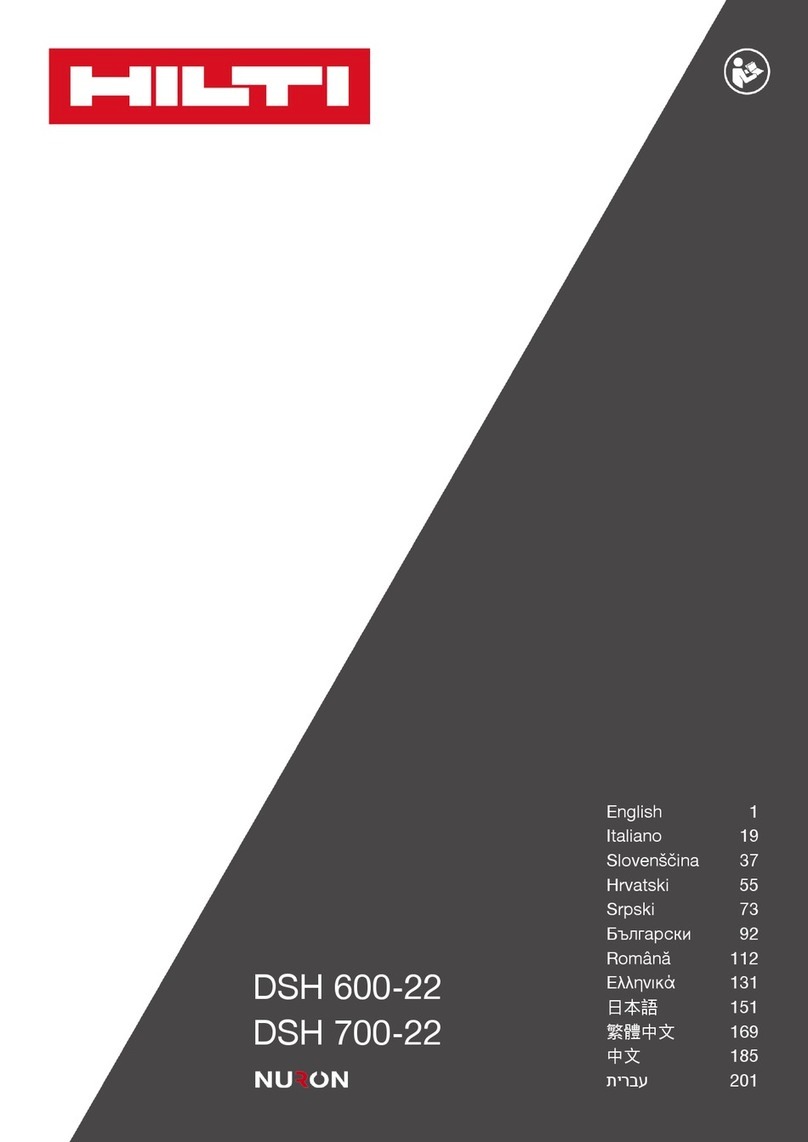
Hilti
Hilti Nuron DSH 600-22 User manual

Hilti
Hilti DSW 3018-E User manual
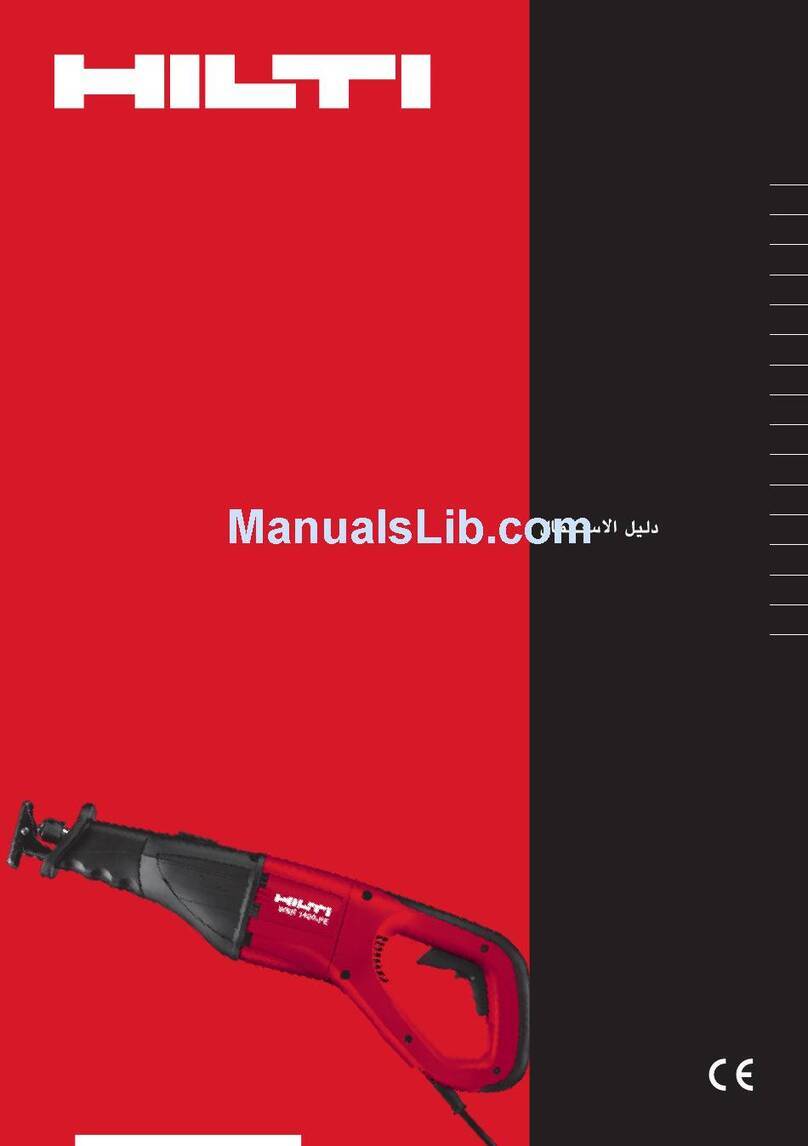
Hilti
Hilti WSR 900-PE User manual
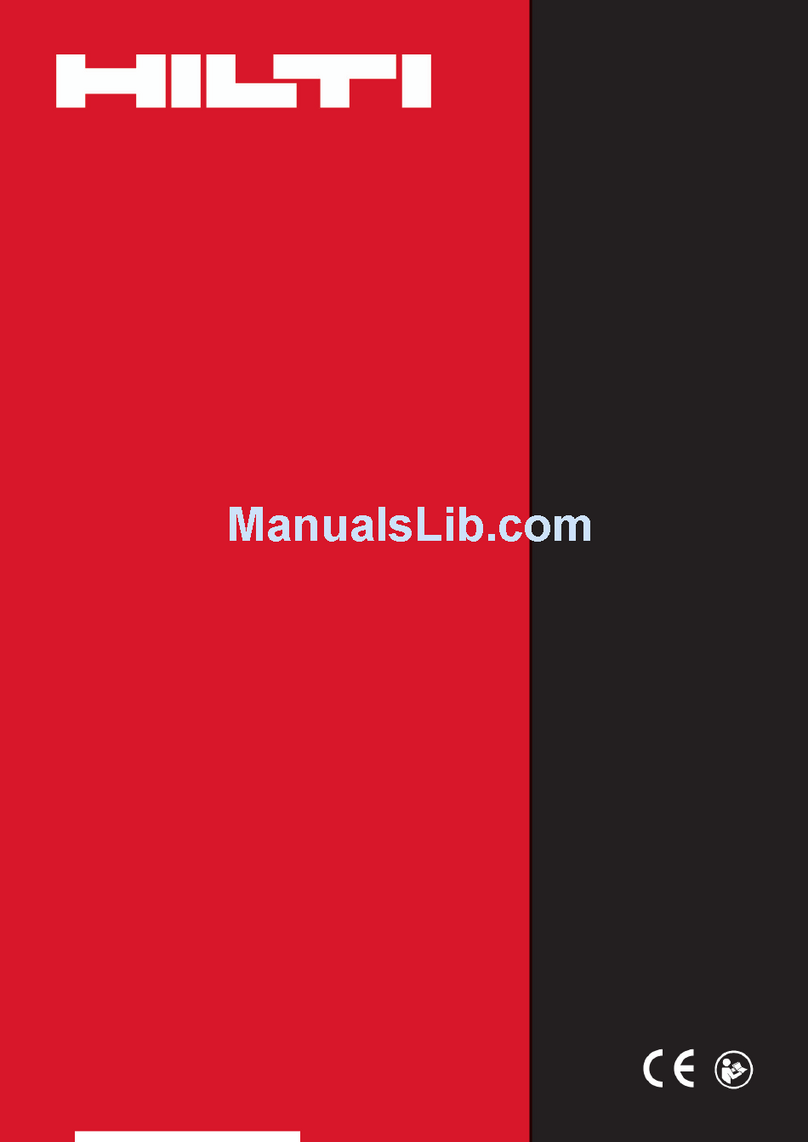
Hilti
Hilti SCW 22-A User manual

Hilti
Hilti DSH 700 User manual
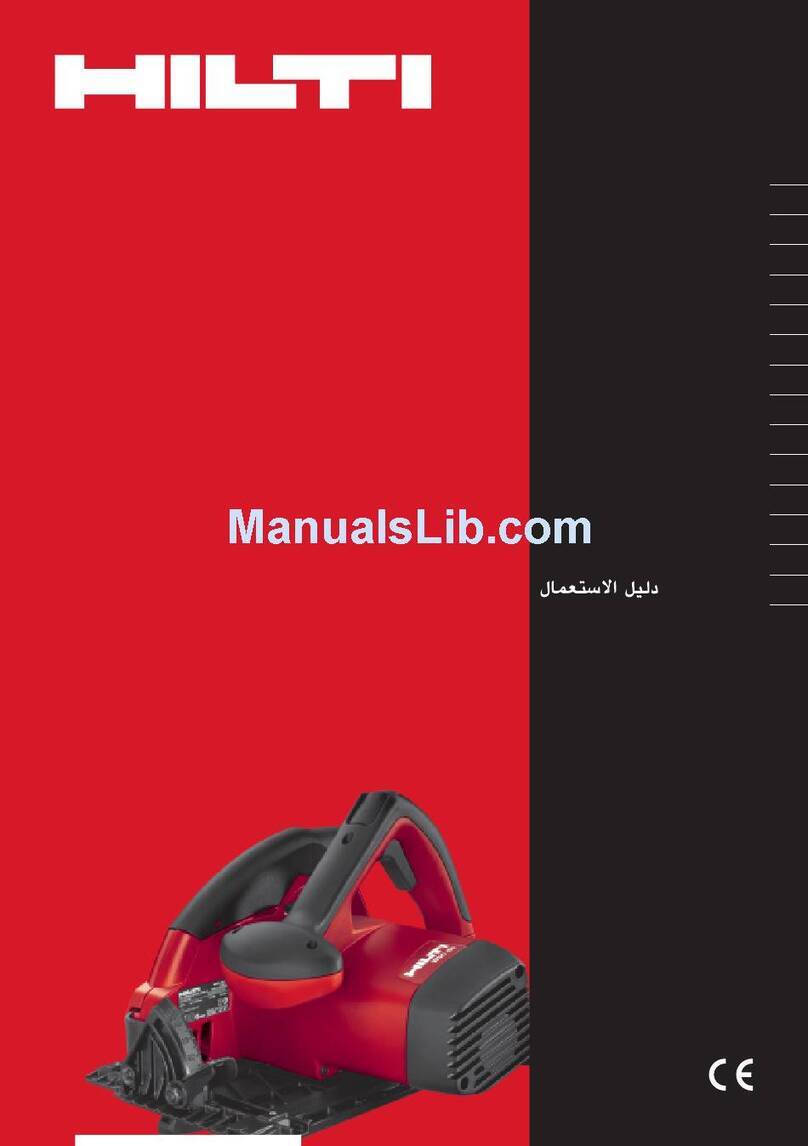
Hilti
Hilti WSC 70 User manual

Hilti
Hilti SC 60W-A36 User manual
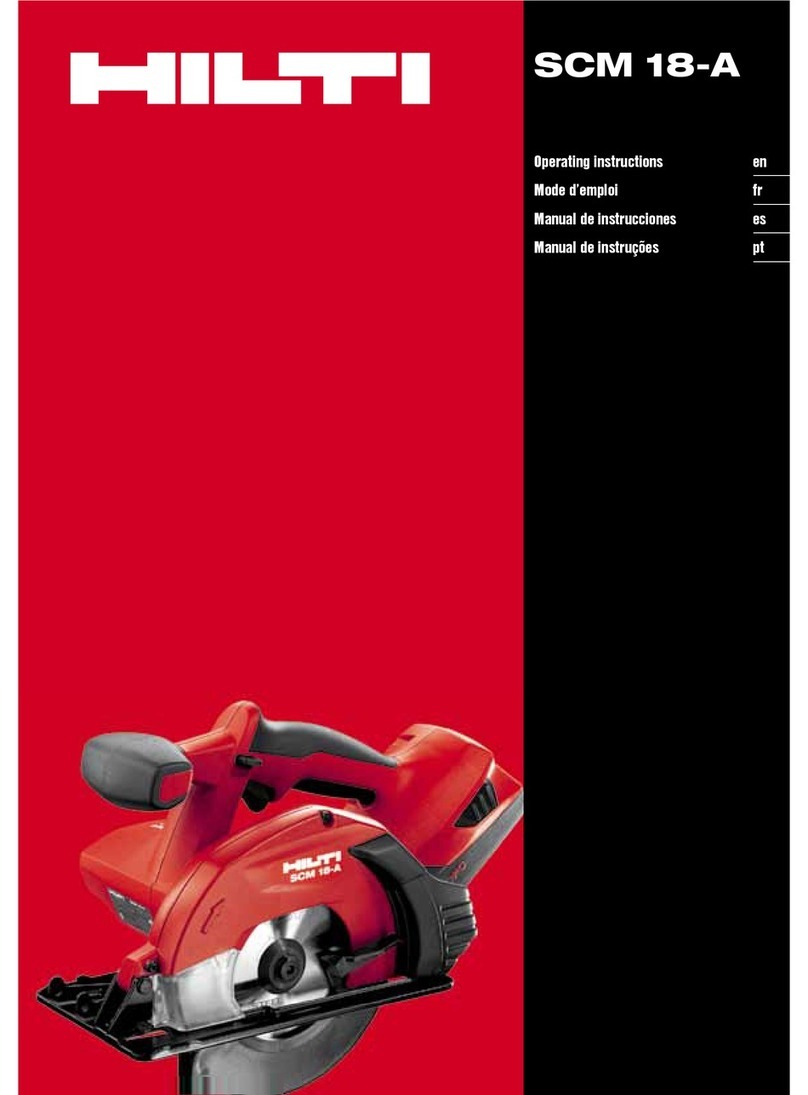
Hilti
Hilti SCM 18-A User manual

Hilti
Hilti NURON SC 6WP-22 User manual

Hilti
Hilti DST 20-CA User manual
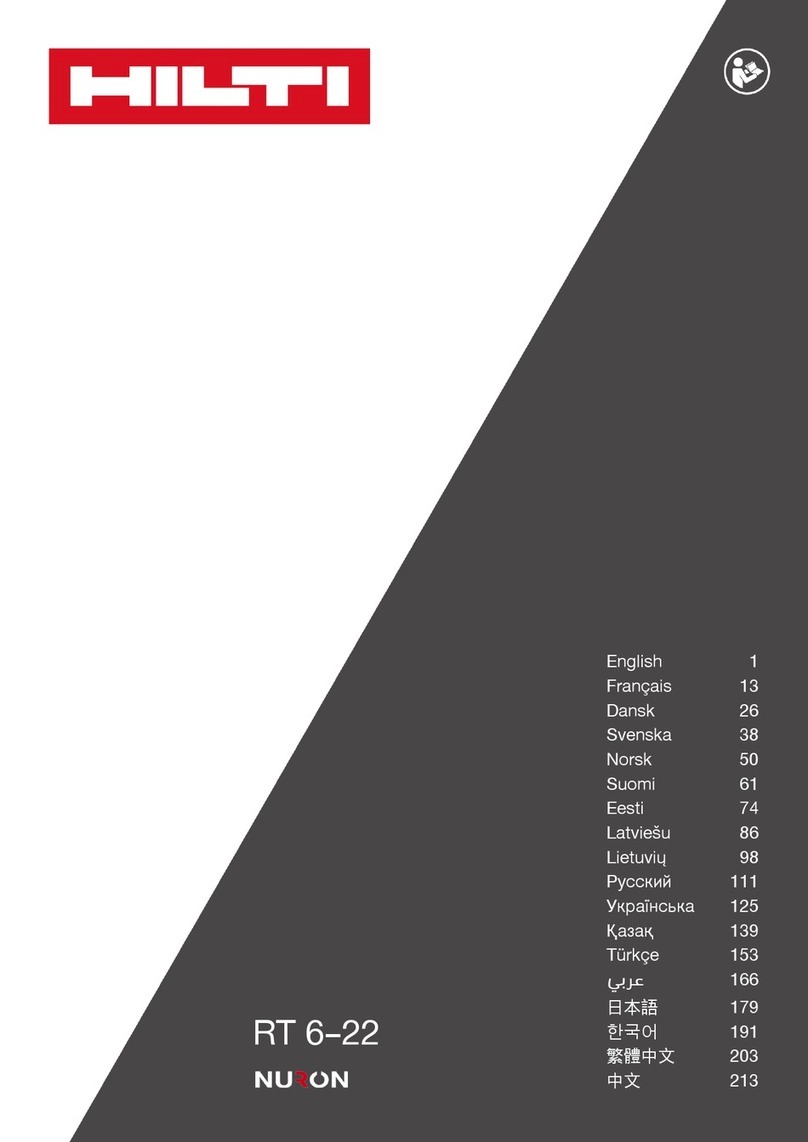
Hilti
Hilti NURON RT 6 22 User manual

Hilti
Hilti DSH 600 User manual

Hilti
Hilti DSW 1510-CA User manual

Hilti
Hilti WSC 85 User manual

Hilti
Hilti Nuron DSH 600-22 User manual

Hilti
Hilti SR 30 User manual

Hilti
Hilti WSC 85 User manual

Hilti
Hilti Nuron DSH 600-22 User manual

Hilti
Hilti SCW 22-A User manual
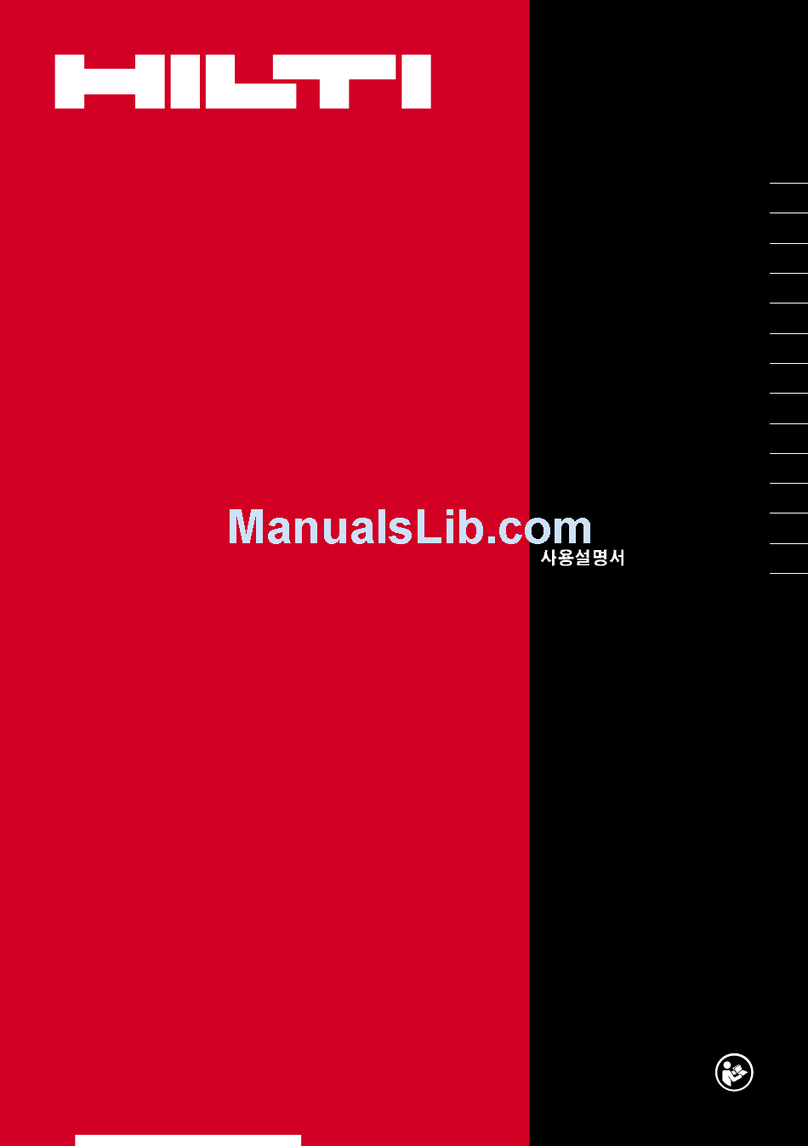
Hilti
Hilti SC 55W User manual
